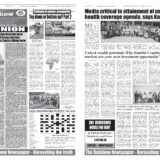Electricity reaches Senior Chief Ntambu and Chief Sailunga’s area’s
Notice: Undefined index: catFilterList in /home/zambi/public_html/wp-content/plugins/wp-likes/api.php on line 243

Pastor Geoffrey Musonda hands over to REA Chief Executive Officer Clement Silavwe
By Derrick Sinjela
AS Zambia increases access to electricity, the Rural Electrification Authority (REA) Chief Executive Officer Clement Silavwe is delighted that Kasanjiku Mini Hydro Power Station in Mwinilunga District of the North-Western Province is set to benefit over 12,000 people at a cost of US$8.6 million and scheduled for handover in 2021.
An elated Mr. Silavwe said in an interview in Lusaka that the Kasanjiku project located on the Kasanjiku River in Mwinilunga District of the North-Western Province will improve the quality of life for beneficiaries at household and community level in both Senior Chief Ntambu and Chief Sailunga’s area.
With learners back in school on Monday January 18th 2021, teachers, pupils, nurses, doctors and patients in health facilities including commercial and public sector institutions in the two chiefdoms will increase output and farmers’ irrigation capacity will be boosted.
“The Rural Electrification Authority continues working responsibly by adhering to the measures enforced by Zambia’s Health Minister Dr. Chitalu Chilufya, Permanent Secretary for Administration Kakulubelwa Caroline Mulalelo and Permanent Secretary for Technical services Dr. Kennedy Malama,” Mr. Silavwe explained in an apparent reference to the second wave of the dreaded Coronavirus.

Senior Chief Ntambu and Chieftainess Muwezwa of Itezhi-Tezhi at a WWF Chilanga Golf Club tree planting Saturday 19 Dec 2020 pix by Derrick Sinjela
As at Thursday 15th November 2018, Construction works on the 0.64 megawatts Kasanjiku Mini Hydro Power Station in Mwinilunga District had reached 95 per cent completion.
Speaking during his site inspection of the power station, then Rural Electrification Authority (REA) Chief Executive Officer Pastor Geoffrey Musonda said he was proud of works done on the project. Pastor Musonda expressed optimism that the project will start providing power once completed in December 2018.
“We are proud of the 95 per cent construction works that have been done on the power station. Therefore, we are set to begin supplying power by December 2018 as planned,” Pastor Musonda said.
According to a United States Agency for International Development (USAID) Power Africa Fact Sheet, Zambia has 2,800 MW of installed electricity generation capacity, of which 85% is hydro based. National access to electricity averages at 31% with 67% of the urban and 4% of the rural population having access to power.
In 1996, the Government of the Republic of Zambia (GRZ) set a goal for universal electricity access for all Zambians by 2030 as energy has been identified as an important driving force behind economic development in Zambia, and authorities commit to develop and maintain energy infrastructure and services.
Although there are pockets of private sector activity in generation, transmission, and distribution, referred to as Independent Power Producers (IPPs), the vast majority of power in Zambia is operated by ZESCO, the vertically integrated state-owned utility.
However, as the sector is opening up to new IPPs for on-grid and off-grid transactions. GRZ expects to bring online additional Mega Watts of solar, hydro, and thermal power through 2020.

President Lungu, ZESCO MD and Energy Minister David Mabumba





















